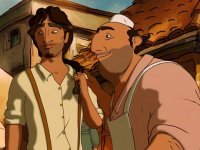Kahlil Gibran: Humanity Through Poetry
Kahlil Gibran, known for the accessibility and warm humanity of his poems, provides students with a window onto an often misunderstood and misrepresented culture.
As you picked up the newspaper or logged on to a news site this morning, you almost certainly saw the term "Middle East," probably detailing a crisis. Most readers understand that the term refers to the countries of southwestern Asia and North Africa. However, stop for a minute to think about the unspoken connotation of the term "Middle East." East of what? Of Europe, of course, and eventually, of the United States. The very term connotes a European/American stance.
Dispelling Stereotypes
How can you (and your students) learn to think about this region a little differently? One way is certainly through literature. Literature classes today are more inclusive than in the past: Asian, African, and Latin American selections now appear in our world literature classes, while we read Asian American, African American, Latino, and Native American stories in our American lit classes. Why aren't we learning more about the region that we call the Middle East?
Our first step is dispelling stereotypes. We Americans tend to equate the Middle Eastern region with Arabic people and the Islamic religion. However, not all Muslims are from that area. The nation with the greatest Muslim population is actually Indonesia. Not all Arabs are Muslim. Some are Christian and Jewish. Not all Muslims are Arabic. According to the Council on American-Islamic Relations, only about 20 percent of Muslims are from the Arabic-speaking world. How many of your students (or their parents) know that Iran is not an Arab nation? Your social studies students would be well served by learning about this religious and demographic complexity.
But dispelling stereotypes is not enough. Step two is identifying literature that either originates in this region or is written by immigrants from this region. Finding these works to use in your survey classes is not always easy, but the effort is important.
Teaching Kahlil Gibran's The Prophet
The Prophet, a work by Lebanese poet Kahlil Gibran, is very accessible for students. Born in Lebanon, educated in Lebanon, Boston, and Paris, Gibran led a truly multicultural life. Although he wrote his most important work in English, he also wrote in Arabic. His drawing and paintings also reflect both Arabic and Western influences. The Prophet, a collection of 26 poetic essays well-known in the 1960s and 1970s, is eminently suited for today's high school classrooms. Much more about Gibran, including a biography and a photo gallery of his paintings, can be found at the Gibran National Committee's website. A new paperback edition of The Prophet will be available from Random House this fall.
Do some of your students have helicopter parents who don't know how to give their adolescent room to grow and learn independence? Gibran's poem "On Childhood" calls children "living arrows" sent forth from the parent's bow. The bow can no longer control the arrow's flight once it is released:
Adolescent hormones acting up? Help your students think more healthily about the nature of real love with Gibran’s poem "On Marriage," where he reflects on the need for two people in love to be strong and independent beings:
(Your lovestruck students may prefer his sensuous poem "On Love," however!)
For students engaged in competitive academics and feeling great stress, try his poem "On Work," which gives dignity and purpose to work of all kinds:
Visualizing the Poetry
One appealing way to introduce your students to Gibran is to have them see the new film, Kahlil Gibran's The Prophet. The animated framing story tells of an imprisoned painter and writer named Mustafa (played by Liam Neeson) who is released from house arrest and sent into exile by an oppressive government. As he walks from his house to the port city, villagers seek his advice, and he responds with poems. Following him and listening to them is a mischievous little girl. The truly remarkable aspect of the film is that each of the eight poems he recites on his journey is interpreted by a different gifted animator in his or her own style. These animators come from all over the world, creating a truly multicultural film.
A complete set of lesson plans for teaching about Gibran himself, his visual art, and the eight poems featured in this film can be downloaded for free. More information about the film, including a trailer and stills, may also be found at the same site. The download includes two PowerPoint slideshows with images from the film for analysis, plus slides of Gibran’s own drawings and paintings. Lessons are suitable for middle and high school classes in English, social studies, art, and art history classes.
How have you used poetry and other literature to teach your students about other regions and cultures? Please tell us about it in the comments section of this post.
